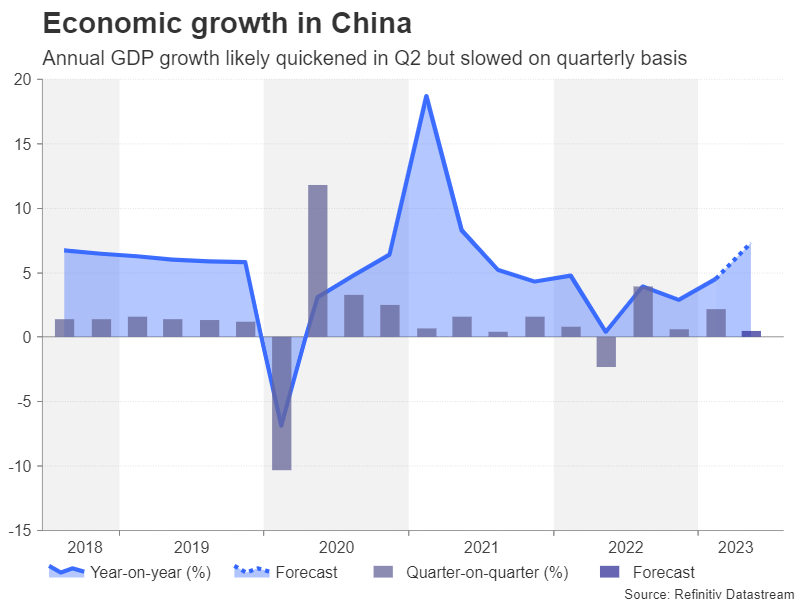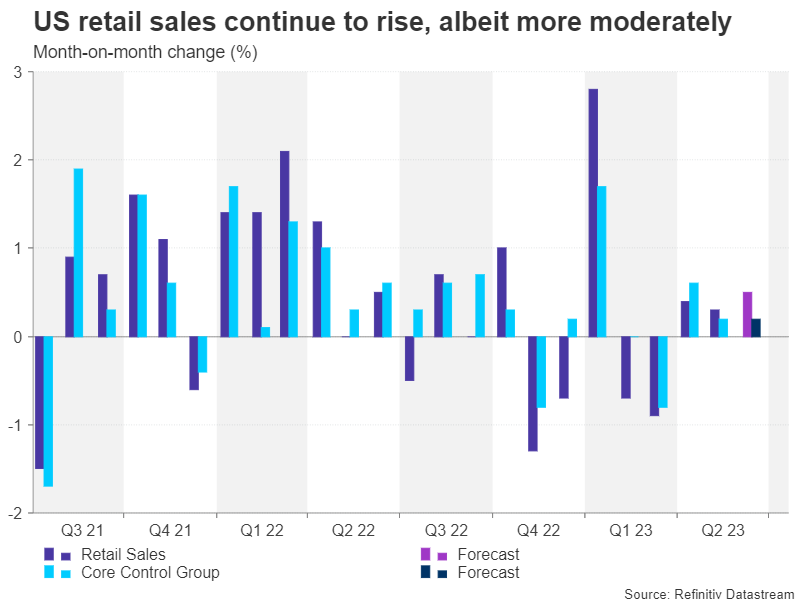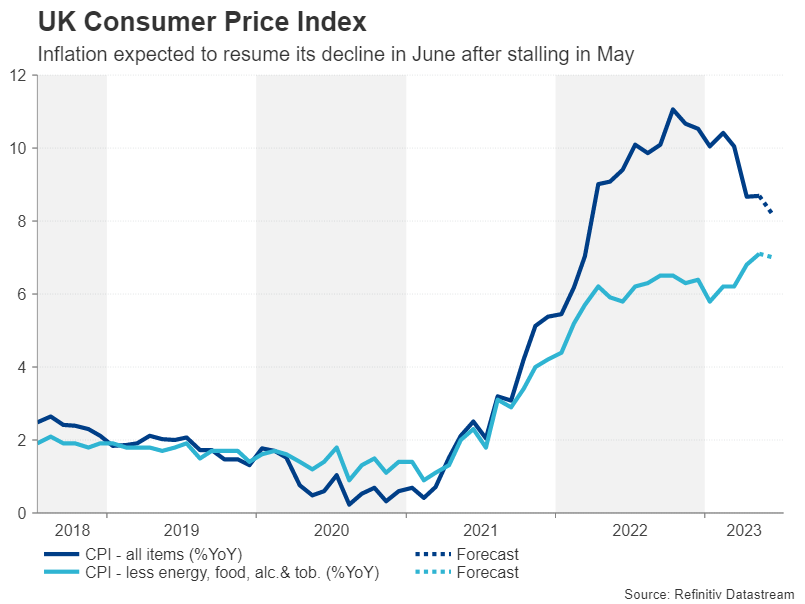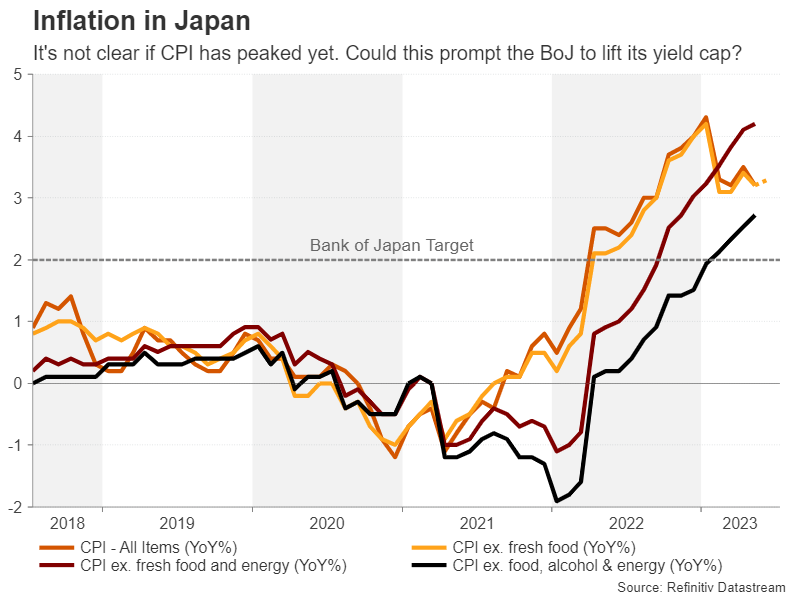Chinese GDP rebound could mask cracks below the surface
China is rarely out of the headlines these days amid persisting fears that the economic recovery is faltering and doubts about how far the government is willing to go to pump more stimulus. On Monday, when the second quarter GDP estimate is reported, investors will likely breathe a sigh of relief, at least initially.
The economy is expected to have expanded by 7.3% year-on-year, which would make it the fastest growth since the second quarter of 2021. However, GDP shrank in the same quarter of 2022 so this would flatter the annual comparison. Moreover, on a quarterly basis, growth is projected at just 0.5%, which is below China’s average and well below the pace that is needed to achieve yearly growth of around 5% that the government is aiming for.
The underlying weakness will also likely be on full display in the monthly prints on industrial output and retail sales. Industrial production growth is forecast to have slowed from 3.5% to 2.7% y/y in June, and retail sales from 12.7% to 3.2% y/y.
US data will have a hard time lifting the dollar
A central bank that will likely ‘unpause’ at its next meeting is the Federal Reserve. There seems to be a strong consensus among Fed officials that some further tightening is still required. But after the downside surprise in CPI, markets are more convinced than ever that a July hike would be the last. More crucially, investors have ramped up their bets of aggressive rate cuts in 2024, hammering the US dollar in the process.
It’s therefore going to be tough for next week’s US releases to switch those expectations around, meaning the dollar’s woes might not lessen anytime soon.
The data flurry will begin on Monday with the Empire State manufacturing index, followed by retail sales and industrial production on Tuesday. Growth in retail sales is expected to have quickened slightly to 0.5% month-on-month, suggesting consumer spending remains healthy while the summer season is in full swing.
Building permits and housing starts are due on Wednesday, with existing home sales coming up on Thursday, along with the Philly Fed manufacturing index. The US housing market is displaying some tentative signs of a recovery and a further indication of that next week might aid the greenback claw higher.
Will UK CPI resume its decline?
One of the currencies riding high on the back of the dollar’s drubbing is the pound. The British currency has stormed above the $1.30 level for the first time since April 2022. However, the rally will be put to the test on Wednesday when the latest UK inflation figures are published.
The consumer price index has repeatedly beaten expectations this year, causing a headache for the Bank of England. The most striking feature of the UK’s stubbornly high inflation problem is that core CPI has yet to peak after almost 500 basis points of rate increases.
There might be some reprieve for policymakers, though, if inflation drops to 8.2% y/y in June as expected from 8.7% in the prior month. Core CPI is projected to moderate too, but only negligibly to 7.0% y/y.
Retail sales data due Friday will also be watched.
Having already jumped by over 3.0% in July alone, the pound is at risk of a sharp correction should the CPI numbers miss the forecasts for once. However, even in this scenario, sterling’s prospects would remain significantly more bullish than its peers’ as the Bank of England would still have a longer tightening path ahead of it than other big central banks like the Fed and ECB.
Japan, New Zealand and Canada awaiting CPI reports too
The Reserve Bank of New Zealand kept its cash rate on hold at its July meeting, signalling that rates have likely peaked. The quarterly CPI readings out Wednesday are anticipated to support that decision as inflation is forecast to have fallen from 6.7% to 5.9% y/y in the three months to June.
But like the pound, the perked-up New Zealand dollar is in danger of a pullback should inflation decline more than expected.
The Bank of Canada on the other hand decided to raise interest rates this week and kept the door open to more. However, with inflation hitting a two-year low of 3.4% in May, investors are unsure if the BoC will hike again.
On Tuesday, the June CPI numbers are due and may stir things up for the Canadian dollar if BoC bets are blown in a particular direction.
The inflation releases will wrap up on Friday in Japan where speculation is growing about a possible tweak in policy by the Bank of Japan. Friday’s data could be important in helping policymakers make up their minds if they should lift or remove the upper limit on the 10-year JGB yield.
Headline and core CPI appear to have plateaued in Japan but the so-called ‘core core’ rate continues to climb. Thus, any upside surprises in the June figures could fuel speculation of a July move, boosting the Japanese yen, which is having its best week since November last year.





